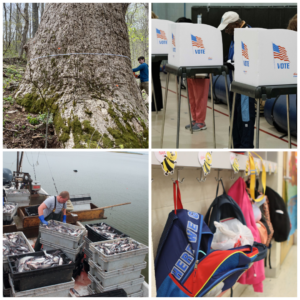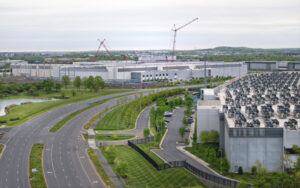“They said ‘Ralph, if you mention sea level rise, that equates to climate change and that’s a nonstarter.’ … I went back and rewrote the legislation and called it recurrent flooding and they said, ‘OK. That’s fine,’ ” Northam said. “It’s all about having relationships here in Virginia, it’s about having experience. It’s about agreeing to disagree. … We call that the Virginia Way.”
12:22
News Story
With new roadmap to combat rising seas, Virginia officially acknowledges the threat of climate change
Virginia will no longer sidestep recognition that climate change is occurring and poses an existential threat to the state’s way of life, shoreline, economies and resources, a new planning document released by Gov. Ralph Northam’s administration Thursday reveals.
The report, called the Coastal Resilience Master Planning Framework, heralds a shift in the Old Dominion’s approach to an issue on which more than 99 percent of global scientists have reached consensus but is still frequently portrayed as controversial in state and national politics.
“To date, Virginia has slowly advanced efforts to study and mitigate coastal flooding without stating unequivocally that climate change is the root cause of the problem,” the framework announced Tuesday reads. “This approach, born of political necessity, has led to tortured titles like the Center for Recurrent Flooding Resiliency and the Joint Subcommittee to Recommend Short-Term and Long-Term Strategies Minimizing the Impact of Recurrent Flooding and Coastal Storms.
“More importantly,” it continues, “it has hampered honest dialogue and broader understanding of the challenges we face.”
Virginia Secretary of Natural Resources Matt Strickler called the acknowledgement that climate change is the primary driver of sea level rise and other major climatic shifts like increased precipitation, rising temperatures and more frequent and intense storm events like hurricanes a “logical kind of follow” to past policy discussions.
“People who live in coastal Virginia are seeing these impacts every day,” he said. “We felt it was really important to be clear about the science. This is something that we’ve studied a lot and have a high degree of certainty that these impacts are coming and that we need to prepare for them.”
Despite scientific agreement, however, many state and local politicians have been reluctant to openly voice a position on climate change. Virginia Beach officials, the Virginian-Pilot has reported, “rarely, if ever, utter the words ‘climate change’” and “specifically avoid attributing any such change directly to humans.”
In the General Assembly, a joint resolution put forward during the 2020 regular session by Del. Elizabeth Guzman, D-Prince William, that declared “global warming caused by human activity that increases emissions of greenhouse gases has resulted in a climate and ecological emergency” was received along partisan lines in the House, with all support coming from Democrats and all opposition from Republicans. The resolution died in the Senate Rules Committee, where Chair Mamie Locke, D-Hampton, and Senate Majority Leader Dick Saslaw, D-Fairfax, told Guzman the Senate no longer approves resolutions memorializing the legislature’s position or “foreign policy resolutions.”
In a 2017 debate with GOP gubernatorial nominee Ed Gillespie, Northam noted that semantic changes were key to getting Republican support for more study of how sea-level rise will change Virginia, the Richmond Times-Dispatch reported.
Michael Allen, a professor and director of the geography program at Old Dominion University in Norfolk whose research is cited throughout the framework, drew a distinction between the recognition that scientists overwhelmingly agree climate change is occurring and opinions on policy approaches to that change.
“We can discuss and debate the ways in which we can address the challenges,” he said. But when it comes to the science, “At some point you just can’t keep beating a dead horse. The science is clear, as clear as the Earth is round and smoking causes cancer.”

Marching orders for combating rising seas
Beyond its policy prescriptions, the Coastal Resilience Master Planning Framework unfurled Thursday lays out a comprehensive plan for how Virginia will move forward in the coming years as sea levels rise along its coasts.
With more than 10,000 miles of shoreline, Virginia’s coastal region is home to about 70 percent of the commonwealth’s population and much of its economic power, from the federal government centers of Northern Virginia to the the sprawling defense installations of Hampton Roads, where Naval Station Norfolk is the world’s largest naval base and enormous quantities of goods and resources like coal regularly transit the Port of Virginia.
Hampton Roads, however, also has the dubious distinction of having the East Coast’s highest rate of sea level rise, due partly to long-term land subsidence linked to tectonic plate shifting and years of heavy groundwater withdrawals in the southern part of the state. The National Oceanic and Atmospheric Administration, using data from Virginia’s longest-operating tide gauge at Sewell’s Point in Norfolk, has found that the state has seen more than 18 inches of relative sea level rise in the past 100 years. Agency projections show that under the highest sea level rise scenarios, Sewell’s Point could see water levels rise by almost 6.7 feet by 2100.
These increases will have major — and costly — impacts. Recent estimates from Climate Central find that some 250,000 acres of land, 1,469 miles of roads and $17.4 billion in property lie in areas less than five feet above Virginia’s high tide line.
For many Virginians, such threats aren’t just theoretical. Regional flooding has become more frequent over the past decade in not only Hampton Roads, but the more rural and lower-income peninsular areas including the Northern Neck, Middle Peninsula and Eastern Shore.
Summaries included in the Master Planning Framework detail a staggering array of initiatives and efforts undertaken by local and regional government bodies to combat rising waters. Virginia Beach hired consultant Dewberry to conduct a five-year coastal adaptation study, which was approved by City Council with much fanfare this summer. The Middle Peninsula Chesapeake Bay Public Access Authority has for years been helping property owners turn over threatened land that could provide a buffer in exchange for tax benefits.
The Eastern Shore’s Transportation Infrastructure Inundation Vulnerability Assessment has been working to determine how much of the region’s transportation infrastructure is at risk from sea level rise (one Coastal Management Zone Program study found almost 14 percent of the Shore’s state roads could be permanently inundated by 2060). The U.S. Army Corps of Engineers’ Coastal Storm Risk Management Feasibility Study examines the problem of flooding along parts of the Potomac.

The lists go on and on. And with sea level rise accelerating, that multiplicity risks inefficiencies and even could exacerbate some impacts if communities don’t collaborate with each other, the framework points out.
“A huge part of the Planning Framework is trying to align all the efforts that are taking place,” said Strickler. “There’s a real need out there to help localities and at the same time leveraging the federal resources, aligning the state resources in a way that we can help everybody and make sure there aren’t unintended consequences.”
Under the new document’s approach, the regional and planning district commissions that oversee Virginia’s coastal areas will be grouped into four new entities based on ecological, economic and cultural similarities: Hampton Roads; Rural Coastal Virginia, including the Middle Peninsula, Northern Neck and Eastern Shore; Fall Line North, encompassing Northern Virginia south to the Rappahannock; and Fall Line South, including the greater Richmond and Petersburg regions. Each will be charged with identifying and prioritizing projects.
These regions will also play a key role in shaping the next phase of the state’s strategy: the Coastal Resilience Master Plan itself, which the Northam administration expects to be issued by December 2021. While a new technical advisory committee will helm the drafting of that plan, the framework requires not only input from the new regions but the convening of a series of regional roundtables over the next months.
Once completed, the master plan, ordered as part of Northam’s Executive Order 24 in November 2018, will map out the specific projects and programs to be undertaken, as well as how they will be financed. Green, or nature-based, solutions like living shorelines will be prioritized where possible, and consideration of equity issues — who will bear the brunt of adverse impacts or enjoy the benefits of any solutions — will be required.
“We have the information necessary to identify the location of affected communities and the risks they face,” the framework states. “We will work with these communities to plan, implement and support successful and lasting adaptation and protection strategies. We must begin now to develop these strategies.”
Not all will be optimal: numerous times throughout the framework there is acknowledgment that relocations will not only be necessary but inevitable.
“We must recognize that protecting every component of the built environment exactly where it stands today is not realistic,” the framework concludes. “In time, some homes, businesses, roads, and communities will become uninhabitable as sea level rises.”
While Strickler said “it’s clear some areas are going to be permanently inundated,” he also cautioned that “we’re not telling anybody they have to move.”
“We’re trying to assist communities and provide incentives to do smart, long-term planning,” he said. “But we wanted to acknowledge that the realities of climate change and sea level rise are clear, that there are places that are at significant risk.”
The Evidence for Climate Change
There is overwhelming consensus among scientists that the Earth’s climate is warming, and that this warming is largely driven by human action. Although regions have always experienced natural temperature fluctuations, long-term temperature records show an “unequivocal” warming trend since the 1950s. Other measurable changes such as accelerated melting of glaciers and ice sheets, sea level rise and increasingly extreme weather provide further clear evidence that warming is occurring. According to the United Nations Intergovernmental Panel on Climate Change, which draws on research by thousands of scientists worldwide, this warming is “extremely likely” (defined as greater than 95% probability) to have been caused by human actions, particularly the release of “unprecedented” levels of greenhouse gases into the atmosphere since the mid-20th century. The U.S. Fourth National Climate Assessment released by the Trump administration in November 2018 similarly found that “observational evidence does not support any credible natural explanations for this amount of warming.”
Sources: IPCC, Climate Change 2014: Synthesis Report; NASA, “Climate Change: How Do We Know?”; U.S. Fourth National Climate Assessment.
This story has been updated to correct the year of Northam and Gillespie’s debate. It occurred in 2017.
Our stories may be republished online or in print under Creative Commons license CC BY-NC-ND 4.0. We ask that you edit only for style or to shorten, provide proper attribution and link to our website. AP and Getty images may not be republished. Please see our republishing guidelines for use of any other photos and graphics.





